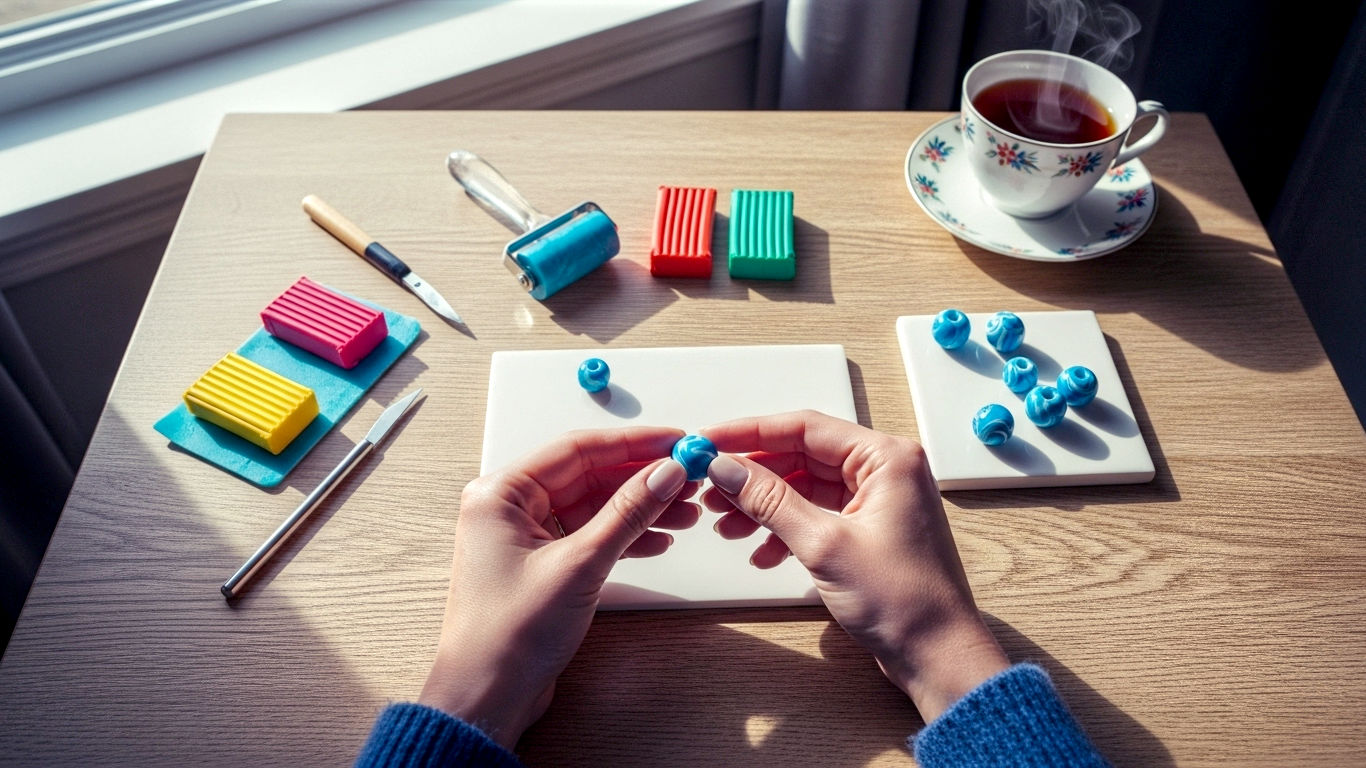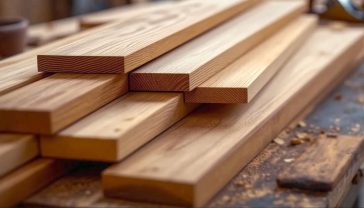The Great British Bead-Making Guide: Your Journey from Beginner to Artisan in 8 Simple Steps
Discover the joy of bead-making! Our comprehensive 8-step guide covers everything a UK beginner needs to know to create stunning, handmade beads at home.

This post may contain affiliate links. If you make a purchase through these links, we may earn a commission at no additional cost to you.
Have you ever looked at a beautiful piece of jewellery and thought, “I wish I could make that”? Well, you can. Welcome to the wonderful world of bead-making, a craft as old as time itself, that you can master right from your kitchen table. It’s a hobby that lets you create something truly unique, whether it’s a colourful necklace, a delicate bracelet, or a quirky keyring.
Bead-making isn’t just about stringing pretty things together; it’s about crafting tiny pieces of art. Imagine turning a simple lump of clay or a piece of glass into a shimmering, colourful bead. It’s a bit like magic, really. This craft has a rich history in Britain, from ancient jet beads found in Whitby to the vibrant glass beads of the Victorian era. Today, it’s enjoying a massive comeback. People all over the UK are discovering the joy of creating their own bespoke jewellery, and you’re about to join them.
This guide is your friendly companion, designed to walk you through everything you need to know. We’ll break it down into eight simple steps, taking you from a complete novice to someone who can confidently create stunning, professional-looking beads. We’ll cover everything from the basic tools you’ll need (don’t worry, you won’t need a huge workshop) to the different materials you can use and the techniques that will bring your creations to life.
So, grab a cuppa, get comfortable, and let’s start this exciting journey together. By the end of this guide, you won’t just know how to make beads; you’ll have the skills and confidence to let your creativity run wild.
Step 1: Choosing Your Material – The Heart of Your Bead
Before you can make a bead, you need to decide what it will be made of. This is the fun part where your imagination starts to take flight. The material you choose will affect the look, feel, and style of your finished beads. Think of it like choosing the ingredients for a cake – each one brings a different flavour. For beginners, some materials are much friendlier than others.
Let’s explore the most popular options you can easily work with at home.
Polymer Clay: The Beginner’s Best Friend
If you’re just starting, polymer clay is your go-to material. It’s soft, easy to handle, and comes in a rainbow of colours. It feels a bit like grown-up plasticine. You can mix colours together to create new shades, roll it, shape it, and even add textures to it.
- Why it’s great for beginners: It’s incredibly forgiving. If you make a mistake, you can just squish it up and start again. It doesn’t dry out in the air, so you can take your time perfecting your design.
- How it works: You shape the clay into your desired bead form, poke a hole through it, and then bake it in your regular home oven to harden it. It’s as simple as that.
- What to buy: Brands like Fimo, Sculpey, and Cernit are widely available in UK craft shops like Hobbycraft or online. A starter pack with a few different colours is a perfect way to begin.
Air-Dry Clay: No Oven Needed
Air-dry clay is another fantastic option for newcomers. As the name suggests, you don’t need an oven. You simply shape your beads and leave them to dry in the air.
- Why it’s a good choice: It’s super simple and safe, making it a great activity to do with older children. It has a lovely, earthy feel and is perfect for creating rustic or bohemian-style beads.
- How it works: You shape it, make a hole, and then let it sit for a day or two until it’s completely hard. Once dry, you can paint your beads with acrylic paints and seal them with a varnish.
- Things to keep in mind: It can be a bit more fragile than polymer clay, so it’s best for chunkier beads. It also shrinks slightly as it dries.
Glass Beads: The Art of Fire (Lampworking)
Making glass beads, also known as lampworking, is a more advanced technique, but it’s utterly mesmerising. It involves melting rods of coloured glass in a very hot flame and winding the molten glass around a metal rod to form a bead.
- Is it for beginners? Honestly, it’s more of an intermediate to advanced skill. It requires special equipment, including a torch and safety gear, and a bit of practice to get the hang of. It’s something you can aspire to!
- The result: You can create stunning, intricate beads with incredible depth of colour and patterns. Think of the beautiful Murano glass beads from Italy – that’s the kind of magic you can create.
- Getting started: If you’re serious about this, it’s best to find a beginner’s lampworking course in the UK. This will teach you the safety essentials and basic techniques in a controlled environment.
Other Creative Materials
Don’t feel limited to clay and glass. You can make beads out of almost anything!
- Paper Beads: A brilliant, eco-friendly option. You roll strips of paper from old magazines, wrapping paper, or even wallpaper around a cocktail stick and glue the end down. A coat of varnish makes them surprisingly durable.
- Felt Beads: By using a technique called needle felting, you can create soft, colourful wool beads. They’re lightweight and perfect for making cosy, textile jewellery.
- Resin Beads: You can pour liquid resin into silicone moulds to create crystal-clear beads. You can even embed tiny flowers, glitter, or colours into the resin for a unique look.
For now, we’ll focus mainly on polymer clay, as it’s the most accessible and versatile material for anyone starting their bead-making adventure at home.
Step 2: Gathering Your Tools – Your Bead-Making Toolkit
Now that you’ve chosen your material, it’s time to assemble your toolkit. You don’t need to spend a fortune to get started. Many of the tools you’ll need might already be hiding in your kitchen drawers or craft box. Here’s a rundown of the essentials for working with polymer clay.
The Absolute Must-Haves
These are the non-negotiable items you’ll need to kick things off.
- A Clean Work Surface: This is crucial. Polymer clay picks up every speck of dust and fluff. A ceramic tile, a sheet of glass (from an old picture frame), or a piece of baking parchment on a smooth table will work perfectly. Avoid working directly on wood, as the clay can stain it.
- A Craft Knife or Clay Blade: You’ll need something sharp to cut your clay cleanly. A dedicated clay blade is ideal as it’s thin and flexible, but a simple craft knife will do the job. Remember to be careful!
- A Rolling Pin: An acrylic roller is best as it’s smooth and easy to clean. You could also use a small glass jar or even a smooth-sided drinking glass. Just don’t use the same wooden rolling pin you use for your pastry!
- Something to Make Holes: This is how you’ll turn your clay shapes into beads. A needle, a cocktail stick, a wooden skewer, or a specific bead-piercing tool will work.
- Your Home Oven and a Baking Tray: You’ll need an oven to cure (harden) your polymer clay beads. Use a dedicated baking tray or an old one you don’t use for food. Covering the tray with baking parchment or a piece of card can help prevent the beads from getting shiny spots on the bottom.
Tools That Are Nice to Have
As you get more into bead-making, you might want to expand your toolkit. These items aren’t essential at first, but they can make your life easier and your beads even better.
- A Clay Pasta Machine: This is a game-changer for conditioning your clay (making it soft and workable) and for rolling out perfectly even sheets. It’s brilliant for blending colours, too.
- Shape Cutters: Small cutters, like those used for cake decorating, can help you create uniform shapes like circles, hearts, and stars.
- Texturing Tools: You can add amazing patterns to your beads using texture sheets. You can also get creative and use everyday items like the end of a pen, a piece of lace, or a crinkled piece of foil.
- Clay Extruder: This tool works like a garlic press. You put clay inside and squeeze out long ropes of clay in various shapes. It’s great for making striped or patterned canes.
- Varnish or Glaze: A coat of special polymer clay varnish after baking will give your beads a professional-looking shine and protect their surface. You can choose between a glossy or matte finish.
Remember, start simple. You can create beautiful beads with just the basic tools. The most important tool you have is your own pair of hands.
Step 3: Preparing Your Workspace and Clay – Getting Set for Success
Alright, you’ve got your clay and your tools. Now it’s time to get everything ready for action. A little bit of prep work now will save you a lot of hassle later and ensure your beads turn out beautifully.
Setting Up Your Creative Corner
Find a comfortable, well-lit spot to work. As we mentioned, a clean surface is key. Before you start, give your work surface a good wipe down with a damp cloth to remove any dust. It’s also a good idea to wash your hands thoroughly.
Top Tip: Keep a packet of baby wipes handy. They are brilliant for cleaning your hands, tools, and work surface, especially when you’re changing between different colours of clay.
Conditioning the Clay
When you first take polymer clay out of its packet, it can be a bit stiff and crumbly. Conditioning is the process of warming and kneading the clay to make it soft, smooth, and easy to work with. This is a really important step. Properly conditioned clay is less likely to crack when you bake it.
- Start with a small piece: Cut off a small chunk of clay from your block.
- Use your hands: Begin by rolling it and squeezing it in your hands. The warmth from your hands will start to soften it.
- Knead and fold: Fold the clay over on itself and press it down. Repeat this process over and over. You’ll feel the clay getting softer and more pliable.
- Roll it into a ball: Once it feels smooth and easy to shape, roll it into a ball. If there are no cracks on the surface, it’s ready to go.
If you’re working with a larger amount of clay, this is where a pasta machine comes in very handy. You can feed the clay through the machine on its thickest setting, fold it, and feed it through again. Repeat this about 15-20 times until the clay is silky smooth.
Mixing Colours
One of the most exciting things about polymer clay is that you can create your own custom colours. It works just like mixing paint.
- To make a lighter shade: Mix a small amount of your chosen colour with some white clay.
- To make a darker shade: Add a tiny bit of black clay. A little black goes a long way, so add it sparingly!
- To create new colours: Try mixing primary colours. For example, a bit of blue and a bit of yellow will give you green.
To mix colours, simply take two conditioned pieces of clay and knead them together until the colour is uniform and there are no streaks. Again, a pasta machine can speed this process up significantly.
Step 4: Shaping Your Beads – From Blob to Beauty
This is where your creativity truly comes to life. You’ve prepared your clay, and now it’s time to shape it into beads. There are countless shapes and styles you can create, from simple spheres to complex patterns. Let’s start with the basics.
Creating Basic Bead Shapes
The best way to learn is by mastering a few simple shapes first.
- The Round Bead: This is the classic. Take a small piece of conditioned clay and roll it between the palms of your hands. Try to apply even pressure to get a perfect sphere. Keep rolling until it’s smooth and round.
- The Oval Bead: Start by making a round bead, then gently roll it back and forth between your palms to elongate it into an oval or tube shape.
- The Cube Bead: Roll your clay into a ball, then gently press it onto your work surface on six different sides to create a cube. You can use a flat tool, like a ruler, to get sharp, clean edges.
- The Disc Bead: Make a round bead, then gently flatten it with your finger or by pressing it under a flat object, like a small tile.
A Handy Tip for Uniformity: If you want to make several beads of the same size, a good trick is to first roll your clay into a long, even sausage shape. Then, use your craft knife to cut it into equal-sized pieces. This way, each bead will start with the same amount of clay.
Adding Holes to Your Beads
A bead isn’t a bead without a hole! It’s best to make the hole before you bake the clay.
- Choose your tool: A needle tool, a cocktail stick, or a skewer works well.
- Support your bead: Hold the bead gently between your thumb and forefinger so you don’t squash the shape.
- Pierce the bead: Slowly and carefully push your needle through the centre of the bead. It helps to twist the needle gently as you push it through.
- Pierce from both sides: For a cleaner hole, push the needle halfway through from one side, then pull it out. Turn the bead around and push the needle through from the other side to meet the first hole in the middle. This avoids creating a messy ‘exit wound’ on one side of your bead.
Once your beads are shaped and pierced, you need to handle them carefully to avoid fingerprints or distorting their shape.
Step 5: Adding Patterns and Textures – Making Your Beads Unique
Once you’ve mastered the basic shapes, you can start experimenting with patterns and textures to give your beads some personality. This is how you can make your creations look truly professional and one-of-a-kind.
Simple Pattern Techniques
Here are a few easy yet effective techniques to try.
- Marbling: Take two or more different colours of conditioned clay. Roll each colour into a thin rope. Twist the ropes together, then fold the twisted rope in half and twist again. Roll this into a ball and then shape your bead. You’ll get a beautiful, unpredictable marbled pattern.
- Stripes: Place thin sheets of different coloured clay on top of each other. Press them together firmly. Then, slice through the stack. When you look at the cut edge, you’ll see stripes. You can then use this striped clay to form your beads.
- Polka Dots: Make your main bead shape. Then, roll tiny little balls of a contrasting colour and gently press them onto the surface of your bead. Roll the bead gently in your palms to embed the dots and make the surface smooth.
Creating Canes: A More Advanced Technique
A ‘cane’ is a log of clay with a pattern running all the way through it. When you slice the cane, each slice reveals the same pattern. It’s like a stick of seaside rock! You can create incredibly intricate designs this way, from flowers to geometric patterns.
Making a simple ‘bullseye’ cane is a great place to start.
- Roll one colour of clay into a thick sausage.
- Roll a second colour into a thin, flat sheet.
- Wrap the thin sheet around the sausage, trimming any excess.
- Gently roll the whole cane to smooth the join and make it thinner.
Now, when you slice your cane, each piece will have a central circle with a ring of another colour around it. You can use these slices to cover a bead made from scrap clay.
Adding Texture
Adding texture can instantly elevate a simple bead. You don’t need fancy tools for this. Look around your home for inspiration.
- Natural Textures: Press a leaf, a shell, or a piece of rough bark onto your clay.
- Fabric Textures: A piece of lace, hessian, or even denim can create wonderful patterns.
- Household Items: The end of a screw, the teeth of a comb, or a crinkled piece of tin foil can all be used to create interesting effects.
Just gently press your chosen texture onto the surface of your unbaked bead. Be careful not to press too hard and distort the shape.
Step 6: Baking Your Beads – The Big Reveal
This is the moment of truth! Baking, or ‘curing’, is the process that transforms your soft, fragile clay beads into hard, durable little treasures. It might sound scary, but as long as you follow the instructions carefully, it’s a straightforward process.
Getting the Temperature and Time Right
This is the most important part of the baking process. Every brand of polymer clay has slightly different baking instructions, so you must always read the packet.
- Temperature: Most polymer clays bake at a relatively low temperature, typically between 110°C and 130°C (230°F – 265°F).
- Time: The baking time usually depends on the thickness of your beads. A common rule of thumb is to bake for about 30 minutes for every 6mm (1/4 inch) of thickness.
Crucially, do not be tempted to whack the temperature up to bake them faster. This will cause the clay to burn, which releases unpleasant fumes and can ruin your beautiful work. It’s much better to bake for longer at the correct low temperature.
Using an Oven Thermometer
Home ovens can be notoriously inaccurate. The temperature on the dial might not be the actual temperature inside. To guarantee perfect results, it’s highly recommended to use a separate oven thermometer. You can pick one up cheaply online or from a kitchen supply shop. Place it in the oven next to your beads so you can see the true temperature.
How to Bake Your Beads
- Preheat your oven: Preheat your oven to the temperature recommended on your clay packet. Let it sit at that temperature for 15 minutes to make sure it’s stable.
- Prepare your baking surface: Place your beads on your dedicated baking tray. To avoid getting shiny spots on the bottom, you can lay them on a piece of paper or card. For round beads, a clever trick is to concertina-fold a piece of card and rest the beads in the V-shaped grooves. This helps them keep their shape. You can also hang pierced beads from a wire rack using skewers or toothpicks.
- Bake them: Place the tray in the middle of the oven and bake for the recommended time.
- Ventilate your kitchen: While polymer clay is non-toxic, it can produce a slight odour when baking. It’s a good idea to open a window or turn on your extractor fan for ventilation.
- Let them cool: Once the time is up, turn off the oven and let the beads cool down completely inside the oven with the door closed. This gradual cooling process helps to make them stronger. They will still be slightly soft when hot, but will harden fully as they cool.
Once they are completely cool, your beads are ready for the final finishing touches.
Step 7: Finishing Your Beads – Adding the Polish
Your beads are now hard and durable, but a little bit of finishing can take them from ‘handmade’ to ‘hand-crafted’. This stage is all about smoothing, shining, and perfecting your work.
Sanding for a Silky-Smooth Finish
Sometimes, your beads might have small imperfections, fingerprints, or a slightly uneven surface after baking. Sanding can solve this. It might sound like a chore, but it can make a huge difference, giving your beads a professional, velvety-smooth feel.
- What you’ll need: You’ll need some wet/dry sandpaper, which you can find in hardware shops. Get a few different grits (the roughness of the paper), starting from a coarser grit (like 400) and moving up to a very fine grit (like 1200 or 2000).
- The technique: This is a wet sanding process to avoid clay dust. Get a small bowl of soapy water. Dip both the sandpaper and your bead into the water and sand gently in a circular motion. Start with the 400 grit to remove any major bumps, then work your way up through the finer grits. The finer you go, the smoother the finish will be.
- Rinse and dry: After sanding, give your beads a good rinse to remove any residue and let them dry completely.
Buffing to a High Shine
If you want your beads to have a natural, subtle sheen without using varnish, you can buff them.
- How to do it: After sanding, you can buff your beads vigorously with a piece of soft fabric, like denim, fleece, or velvet. The friction creates a beautiful, soft lustre. For a really high shine, you can use a buffing wheel on a rotary tool like a Dremel, but be sure to use a low speed and a light touch.
Varnishing for Gloss and Protection
Varnishing is the quickest way to get a glossy finish and it also adds a protective layer to your beads. This is especially important if you’ve used surface effects like metallic powders or paint.
- Choose the right varnish: It’s vital to use a varnish that is compatible with polymer clay. Some varnishes can react with the clay over time and become sticky. Look for a water-based polyurethane varnish or a product specifically sold as a polymer clay glaze. Brands like Fimo and Sculpey make their own.
- How to apply: Use a small, soft paintbrush to apply a thin, even coat of varnish. To avoid drips, you can string your beads on a cocktail stick or a piece of wire to hold them while you paint and let them dry. You may need two or three thin coats for the best result. Let each coat dry completely before applying the next.
Step 8: Using Your Beads – Time to Get Creative!
Congratulations! You’ve made your very own beads. Now for the most rewarding part: turning them into something beautiful and wearable. The possibilities are endless, but here are a few simple project ideas to get you started.
Basic Jewellery Making
You’ll need a few basic jewellery findings, which you can buy in kits from craft shops.
- A Simple Necklace or Bracelet: The easiest project of all. You’ll need some beading thread (like nylon cord, leather thong, or flexible beading wire called Tigertail) and a clasp. Simply thread your handmade beads onto the cord, perhaps mixing them with some smaller seed beads or metal spacer beads. When it’s the right length, tie on your clasp.
- A Pair of Earrings: For this, you’ll need two headpins (long, thin pieces of wire with a flat ‘head’ at one end) and two ear wires. Thread a bead onto a headpin. Using a pair of round-nosed pliers, bend the wire at the top of the bead to create a small loop. Open the loop on the ear wire, attach your beaded headpin, and close the loop again. Repeat for the other earring, and you have a matching pair!
- A Funky Keyring: All you need is a keyring finding and a sturdy jump ring (a small metal ring that opens and closes). You can thread a few of your favourite beads onto a short piece of strong cord, tie it securely to the jump ring, and then attach the jump ring to the keyring.
Beyond Jewellery
Your beautiful beads aren’t just for jewellery. Think outside the box!
- Decorative Suncatchers: String them on clear fishing line to hang in a window.
- Personalised Wine Glass Charms: A great gift idea.
- Stylish Zipper Pulls: Add a bit of flair to a boring coat or bag.
- Unique Christmas Ornaments: Create festive beads to hang on your tree.
This is just the beginning of your creative journey. Bead-making is a wonderfully addictive hobby. Don’t be afraid to experiment with different colours, shapes, and techniques. The more you practise, the more your skills will grow. You’ve now got the foundations to create truly unique pieces of art that you can wear, share, and be proud of. Happy beading!
Further Reading
To continue your bead-making journey, check out these highly respected UK resources:
- The Beadworkers Guild: A fantastic organisation for bead enthusiasts of all levels, offering workshops, publications, and a community of fellow makers. https://www.beadworkersguild.com/
- Beads Direct: A huge UK-based online supplier for all your beading needs, from clay and tools to findings and threads. They also have lots of project ideas and tutorials. https://www.beadsdirect.co.uk/
- Hobbycraft: The go-to high-street craft store in the UK, with a great selection of polymer clay brands and basic bead-making tools. Their website also features helpful guides. https://www.hobbycraft.co.uk/
- The Polymer Clay Guild of Great Britain: A dedicated Facebook group for UK polymer clay artists to share tips, ask questions, and showcase their work. A great place for community and inspiration.






